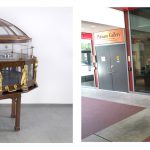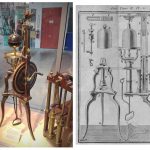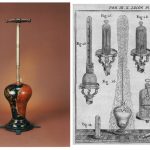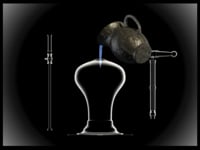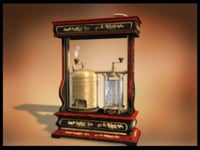Functionless: science museums and the display of ‘pure objects’
Article DOI: https://dx.doi.org/10.15180/160506
Abstract
I argue in this article that the tangible proximity, the sensual evocative power of things is lost in a visit to the museum. Too often the aesthetic form of the exhibition utterly destroys the objects’ core material function. One of my contentions is that we cannot think with objects we are unfamiliar with, or cannot fully grasp and manipulate. In a museum we are compelled to admire the objects’ formal and abstract ‘beauty’. They have been robbed of their function: they are functionless. I address this long-standing dichotomy between form and function. I argue that Art has undesirably become one of the chief criteria of museum exhibition design. Though artistic attributes can at times acquire epistemic value, as I will illustrate with an example taken from the French Enlightenment, modern science exhibition design tends to utterly obscure the latter in favour of the former. Science museums, I propose, need to better adapt their discourse and presentation to the research programme developed over the last thirty years in the field of science studies: the history, philosophy, and sociology of experimentation, in which instrumentation and laboratory performance play a crucial analytical role in our understanding of scientific practices.
Keywords
Abbé Nollet, aesthetic form, instrument display, performative space, pure objects
Introduction
https://dx.doi.org/10.15180/Every object thus has two functions – to be put to use and to be possessed. […] These two functions stand in inverse ratio to each other. At one extreme, the strictly practical object acquires a social status: this is the case with the machine. At the opposite extreme, the pure object, devoid of any function or completely abstracted from its use, takes on a strictly subjective status: it becomes part of a collection. It ceases to be a carpet, a table, a compass or a knick-knack and becomes an object in the sense in which a collector will say ‘a beautiful object’ rather than specifying it…
Jean Baudrillard suggests in Le système des objets that when you take away the elemental attributes and basic use of an object its core identity and distinctiveness are robbed from it. The performing object then becomes a ‘pure object’, an object pushed onto an aesthetic plane that no longer belongs to the practical and tangible space of functionality. Most museum objects face this situation. Either stored in restricted rooms or stuck behind glass exhibit cases for all to see, they typically fail to convey their original function and true (or attributed) purpose. According to Baudrillard, such objects have henceforth taken ‘a strictly subjective status’. Should it matter to us? It matters to Sherry Turkle, whose edited volume on ‘evocative objects’ focuses on the powerful affect everyday things and technological devices have on us. She contends that ‘[w]e think with the objects we love; we love the objects we think with’. To her and to the book’s various authors simple objects offer such an elicitation only if the things under consideration are close to us – almost part of us (Turkle, 2007).[1] It is likewise via the deep familiarity and propinquity of some of the simplest objects – levers, inclined planes, pendulum, and springs – that Renaissance engineers and seventeenth-century mechanical practitioners, including Galileo and Descartes, reframed our understanding of mechanics. These ‘scientists’ were first and foremost physically engaged with the things they were thinking about (Bertoloni Meli, 2006). It is the tangible proximity, the sensual evocative power of things that is lost in a visit to the museum. The aesthetic form of the exhibition utterly destroys the objects’ material function. We cannot think with objects we are unfamiliar with, or cannot fully grasp and manipulate. We are left with but one sense: sight. We are forced to only admire their formal ‘beauty’. In the next few paragraphs I address this long-standing dichotomy between form and function. I argue that Art, with a capital ‘A’, has undesirably become one of the chief criteria of museum exhibition design. Though artistic attributes can at times acquire epistemic value, as I will illustrate with an example taken from the French Enlightenment, modern science exhibition design tends to utterly obscure the latter in favour of the former. Science museums, I summarise, need to adapt their discourse and presentation to one core research programme developed over the last thirty years in the field of science studies: the history, philosophy, and sociology of experimentation, in which instrumentation and laboratory performance play a crucial analytical role in our understanding of scientific practices.
Going beyond the celebration of art and contemplation
https://dx.doi.org/10.15180/160506/002When Sandra Dudley, a well-known scholar in the field of museum studies, visited the art gallery at Compton Verney (Warwickshire) for the first time, she experienced a strong emotion while standing in front of a Chinese artefact, a bronze horse dating back to the Han Dynasty:
I was utterly spellbound by its majestic form, its power, and, as I began to look at it closely, its material details: its greenish colour, its textured surface, the small areas of damage. I wanted to touch it, though of course I could not – but that did not stop me imagining how it would feel to stroke it, or how it would sound if I could tap the metal, or how heavy it would be if I could try to pick it up. I was, in other words, sensorially exploring the object, even though I had to intuit and imagine rather than directly experience most of the encounter. […] Nonetheless its three-dimensionality, tactility and sheer power had literally moved me to tears.
Is Dudley’s reaction unusual? Absolutely not. I feel similar overwhelming emotions every time I visit the Musée Gustave Moreau in Paris. In fact, we all experience at one moment or another such powerful sensations at the sight of objects. What Dudley is attempting to convey and emphasise here is how significant the material qualities of objects are in producing these emotional reactions. The latter are not spawned by a descriptive label on a wall, but by the object itself – by the thingness of the thing. In the same edited volume Simon Knell calls this inherent state of objects the ‘intangibility of things’. He argues that any object, ipso facto a museum artefact, is actually composed of two things: the material and tangible (real) thing itself – not always reachable – and an intangible one, ‘the product of experience and negotiation… [It] exists in our world but is made in our thoughts; it is ever present and inescapable’. Though this immaterial creation ‘appeals to the truth of the material object’ it remains detached and fluid. ‘The object in our thoughts may seem material, definite and fixed but it is in fact intangible, contingent and transient’ (Knell, 2012, pp 326 and 328, emphasis original). In other words, what Dudley experienced so strongly in front of the Chinese artefact is completely dependent on her own personal being. Without the possibility of experiencing the real and tangible museum object with the help of more than one sense, in this case sight, there is no experiential common ground possible. Each visitor is left with her own and distinct contingent ‘intangible object’ based on her own idiosyncratic knowledge and familiarity with matter.
It is interesting to note that there is virtually nothing about the material culture of science in this edited volume. The properties of things are studied under the discipline umbrella of, to name a few, art history, anthropology, archaeology, management studies, history, religion, and of course museum studies. Why not science and technology? Is it not conceivable to feel overwhelmed with emotion when standing near one of Galileo’s telescopes at the Museo Galileo in Florence or underneath the massive space shuttle Discovery at the Steven F Udvar-Hazy Center, companion facility of the Smithsonian National Air and Space Museum in Washington, DC? The answer to this question is obviously yes. But what happens if the object (scientific or not) encountered in a museum is unfamiliar and strange – the opposite of an iconic artefact? Will it produce the same intense emotion on visitors? What would occur, however, if one could fully interact with it? This was the position taken by the Collection of Historical Scientific Instruments at Harvard when it displayed a 1930s teleprinter in the Go ask A.L.I.C.E.: Turing tests, parlor games, & chatterbots exhibition, produced in celebration of Alan Turing’s centenary in 2012.
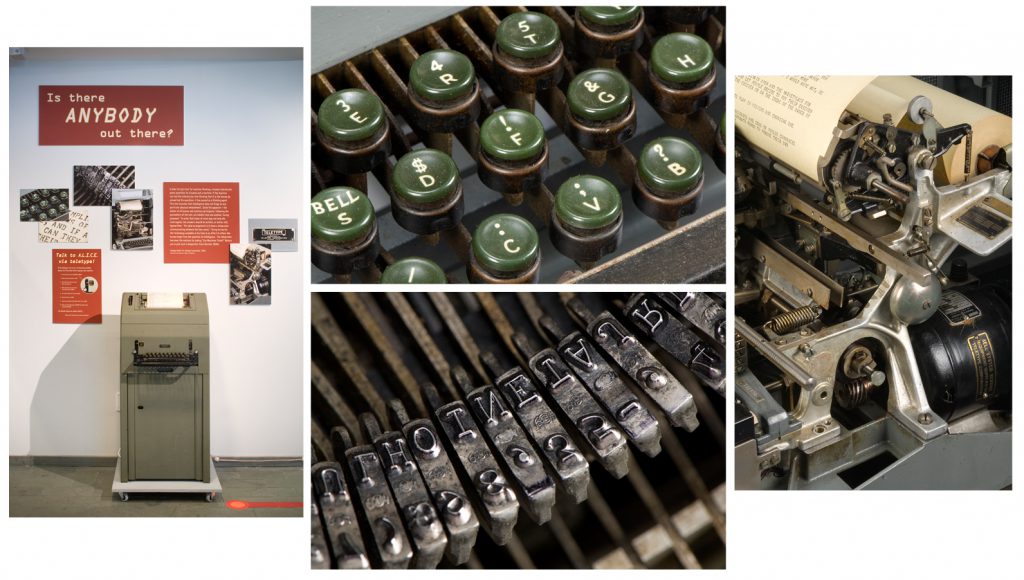
In Turing’s test for machine thinking, we explained in the introductory panel near the entrance, a human interlocutor poses questions to a human and a machine. If the machine can fool the interlocutor into thinking that it is the human by answering the questions, it has passed as a thinking agent. This test assumes that intelligence does not hinge on any particular physical embodiment. Quite the opposite – the bodies of all human and machine participants following the parameters of the test, are hidden from one another. Turing proposes: ‘In order that tones of voice may not help the interrogator the answers should be written, or better still, typewritten. The ideal arrangement is to have a teleprinter communicating between the two rooms’ (Turing, 1950, p 433). Turing turned to the technology available in his time in an effort to efface the human body from the question of intelligence. The teleprinter becomes the medium for asking, ‘Can machines think?’[2]
Visitors confronted with our teleprinter were asked to feel it with all their senses. They found that the keyboard was slightly different than the common QUERTY we are now accustomed to. The keys offered a strong resistance, not unlike old typewriters. The staccato produced by the type bars hitting the paper, especially when the machine received an answer, was alien to the ear. Likewise, with the humming sound generated by the motor and the electro-mechanical vibrations produced when the machine operated, all of which contrasted with the remarkable silence of modern-day portable computers. The faint bitter smell of ink and the radiating heat from the motor completed the sensory experience of the machine. Visitors discovered with pleasure that typing questions on this older artefact generated answers from the chatterbot A.L.I.C.E., which is freely available on the Internet.[3] Though we had to leave out the human factor due to technical issues, the old and the new were still united in a fully functioning machine. Visitors, through their sometime awkward conversation with A.L.I.C.E., were being acquainted with Turing’s concept of communication and intelligence – and with this strange machine. The physical, hands-on interaction with the 1930s teleprinter made Turing Test’s conceptual understanding easier to grasp. And since the visitors’ dialogues were recorded on a roll of paper, their personal connection became a shared experience, not an individual, intangible, contingent or transient one (as discussed above).
Why does it matter? It matters because material culture studies have demonstrated repeatedly the importance of the shifting and fluid, even unstable use of objects in all socio-cultural, historical and scientific fields and time periods. Hide this lesson, shroud it in a learned narrative about emergence and transience and the actual object – particularly the museum artefact – loses its multiple meanings. Its function is destroyed. Caroline Walker Bynum, for instance, reminds us in a remarkable book that medieval ‘Christian materiality’ was all about the senses, the visceral need to be in the proximity of sacred objects to gain the direct and immediate ability of experiencing their powers:
The physicality we encounter in devotional objects (often in their combination of colors, depth of relief, textures, and materials) reflects and results from the fact that they are not so much naturalistic (that is mimetic) depictions as disclosures of the sacred through material substances. […] They ask to be touched, more than seen.
(Bynum, 2011, pp 38 and 41, my emphasis)
How does this translate into the context of a museum? Jan Geisbusch, writing in Dudley’s edited volume, agrees that museums have done a lot to save a wide variety of sacred objects, but ‘they have done so in their fashion, preserving their physical existence, yet bleaching them of energy and meaning’ (Geisbusch, 2012, p 208, emphasis original). He concurs with Bynum on the power of touch vis-à-vis sacred objects, emphasising how much they are ‘a matter of engagement, interest, desire, captivation, manipulation rather than dispassionate contemplation, study, or belief’ (Geisbusch, 2012, p 207).[4] Such a dramatic (I dare say ontological) shift has relegated sacred objects exhibited in museums to the realm of universal and timeless aestheticism. Removed from their original religious context and disconnected from their primary functions they have become objects to be admired only for their beauty (Lipovetsky and Serroy, 2013).[5]
Anthropological artefacts have suffered an identical treatment over the years. In Malaise dans les musées, first and foremost an attaque en règle against the Louvre Abou Dhabi project, Jean Clair criticises the over embellishment of the Musée du quai Branly, calling it a ‘reductio ad aestheticam’. The renowned French conservateur général du patrimoine condemns the museum’s penchant for dismissing the objects’ function to emphasise their form:
Le dialogue que le Musée du quai Branly prétend mener suppose que les œuvres qu’il expose ne veulent ‘rien’ dire. Oublié leur contenu, mises entre parenthèses leurs fonctions ou leur destination, ne demeurent que leurs formes. Cette mise entre parenthèses des destinations, propre à tous les musées d’art, est particulièrement choquante dans un musée qui rassemble des objets qui, hier encore, étaient, et étaient d’abord, des objets de culte.
Clair is not the only one. The philosopher Bernard Deloche, in a small and sometimes vitriolic pamphlet, disapproves of the Musée du quai Branly’s ‘exotic aestheticism’. He underscores the fact that such a practice devitalises the objects and transforms them into relics that Westerners can henceforth fully appropriate for themselves (Deloche, 2010, pp 46–47). The art historian emerita Svetlana Alpers calls this very act the ‘museum effect’. She argues that the museum effect is a way of seeing, or ‘the tendency to isolate something from its world, to offer it up for attentive looking and thus to transform it into art like our own’, i.e. Western art. She finds her own conclusion troubling because it means ‘[i]t is to ourselves, then, that we are representing things in museums’ (Alpers, 1991, pp 27 and 32). A good exhibition does not simply let visitors marvel at the beauty of objects, tuned in to their own idiosyncratic knowledge; it should provide instead the ‘contexts and resources that enable audiences to choose to reorganize their knowledge’ (Karp, 1991, pp 22–23).
I have nothing against art, au contraire. Most early modern instruments now kept in science museums, such as Joseph Pope’s Grand Orrery on display at Harvard, were purposefully designed to be attractive and decorative works of art. Science and art do inform one another, as physicist Robert Wilson demonstrated throughout his long career.[6]
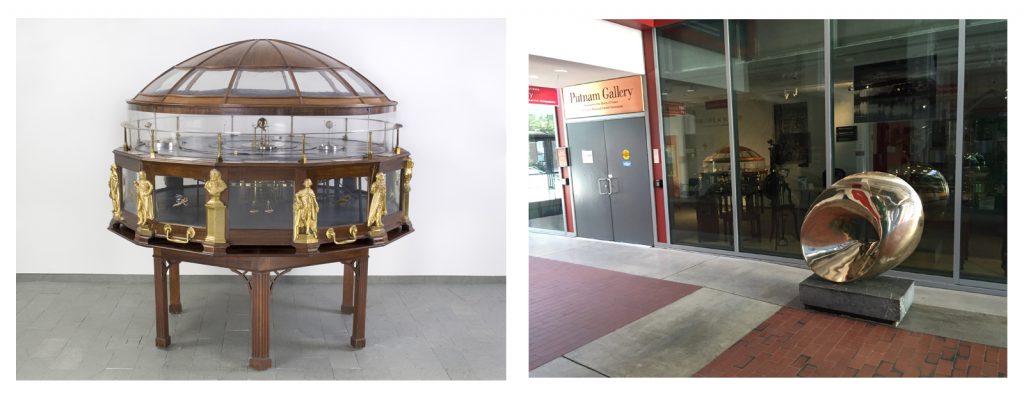
(David Edwards (2008)) even developed an epistemological concept based on the close relationship between art and science, which he calls ‘artscience’.[7] What we see happening nowadays, however, is an imbalanced tilt toward the arts, what Gilles Lipovetsky and Jean Serroy have called the ‘aesthetization of the world’. The authors contend that today’s society of mass consumption has completely merged with art to form the hypermodern category of ‘capitalisme-artiste’. According to the latter category ‘all is art, seen and valued as art’. The hyperconsumer individual has lost all learned appreciation of the past and can nowadays assess objects purely on his or her own personal subjectivity and aesthetic taste (Lipovetsky and Serroy, 2013, p 396). The hyperconsumer homo æstheticus is also confronted with a modern style of architecture that shapes whole buildings into works of art. This ‘visual shock’ emphasises form over functionality. A telling example are the new art museums built in the last few decades: ‘It is them we come to see, more than the collections they house, of which we often know nothing about’ (Lipovetsky and Serroy, 2013, p 282).
Science museums have taken that aesthetic turn as well, and the consequence is a critical loss of socio-historical context and epistemology. Take two recent examples among dozens. The Musée des Confluences in Lyon, recently opened, defines itself as a museum of science and society. On the architects’ website the building’s concept is described as ‘The crystal cloud of knowledge’. Crystal, for the transparency of its meaning and the openness to the visitors and the citizens of the region; cloud for the image of how knowledge of the future is stored.[8] Highly criticised in France for its cost (over 250 million euros) and look, this ‘space-age’, spaceship-looking museum is clearly after the drawing power of the building – the Frank-Gehry-Bilbao effect. (Or, for the pop-culture reference, the Field of Dreams-effect: If you build it, they will come.) Expected to get 500,000 visitors per year, the museum’s collection appears at best secondary, no longer sufficient by itself to bring people in and epitomise the scientific ethos and practices. Some 5,800 miles away, the California Academy of Sciences in San Francisco, at a price tag of 500 million dollars, has been completely rebuilt recently by a ‘starchitect’, Renzo Piano. According to the institution’s Director of Exhibitions, ‘The building is and of itself a large draw for many adults who are fans of architecture and design’. The building itself, not the objects or the science, has become the arbiter of exhibit design: ‘We try to think about the materials that we’re using in our exhibits. […] [They have] to be of an aesthetic and design quality that’s up to par with the building. I think a lot of adults pick up on it consciously or subconsciously’ (Kehl, 2013, p 50). The medium is the message, literally. And that message shouts art history consideration over scientific epistemology and functionality.[9]
This is a recent trend. In Do museums still need objects? (Steven Conn (2010)) examines the changing role of objects in museums since the end of the nineteenth century. While artefacts were then at the centre of the museum’s discourse and the focus of the visitor’s visual landscape, today we can easily foresee a museum almost entirely devoid of objects – though equipped with a café, gift shop, high-end dining and an IMAX cinema. Conn also notices a direct correlation between the rise of museum educational programmes and the sharp decrease of exhibited artefacts over the last several decades. He justly notes that artefacts ‘are no longer as central to the conception and function of the museum’. And when they are made the focus of an exhibition the ones chosen for display, e.g. anthropological artefacts, ‘are selected for aesthetic, rather than cultural or scientific reasons’ (Conn, 2010, pp 58 and 35 respectively).[10] Scientific instruments suffer the very same treatment in science museums. Most of the time they are buffed until they shine (how dare we see dirt and grime!) before being carefully put inside modern, sparkling glass cases. Can we learn anything from these ‘beautiful’ objects? Not if they are fleetingly gazed at. As Baudrillard (2005, p 100, note 23) puts it, ‘any object immediately becomes the foundation of a network of habits, the focus of a set of behavioural routines. Conversely, there is probably no habit that does not centre on an object. In everyday existence the two are inextricably bound up with each other.’ If no means of access is provided to an object’s specific ‘set of behavioural routines’, nothing can be learnt from this object. It has been converted – distorted – into a pure and functionless object.
I will describe in the following section how habit, aesthetic considerations and epistemology were embedded in the instruments designed by Abbé Jean-Antoine Nollet (1700–1770). The multiple functions attached to Nollet’s instrumentarium provide a key analysis of Enlightenment socio-cultural context and natural philosophical practices, which are better understood in light of hands-on knowledge and ‘networks of habit’.
Art, science and the mechanical mastery of nature
https://dx.doi.org/10.15180/160506/003The year Abbé Jean-Antoine Nollet died he dedicated his final opus, L’Art des expériences, to the Dauphin of France. Nollet personally knew the Dauphin since at least 1758 when the latter’s grandfather, Louis XV, officially named the famous lecturer demonstrator and académicien ‘maître de physique et d’histoire naturelle des Enfants de France’. Written for the esteemed pupil, who would become King Louis XVI, the book’s dedication emphasised the role played by Nollet’s scientific instruments and their corresponding leçons de physique in the monarch’s formal education. Not only did the Dauphin attend Nollet’s experimental performances, he enjoyed as well pulling apart and rebuilding the instruments to better understand their mechanism (Nollet, 1770, p iii). In England, the future King George III received a similar scientific education, for which an impressive and highly decorative physics cabinet was commissioned to George Adams the younger (Grant, 2015).[11] Beyond the aesthetic pleasure and the scientific knowledge one gets from the instruments and experimental demonstrations, there was a sense that such an education developed good thinking habits and moral values – qualities required for any virtuous monarch. In all cases, the decorative features found on the instruments, made for princes and kings, never outshined their central utility, certainty and functionality.
The Abbé’s instruments were in fact designed with a deep sense of purpose and performance. Nollet states five rules in L’Art des expériences, motivated by ‘reason and experience’, for constructing scientific instruments:
- In your operations, avoid a superfluous apparatus, which is always costly and which is often capable of inducing error; for the more means one employs, the greater the difficulty of determining the referent for the effect under consideration;
- Use ornamentation in the machines that you construct only with a great deal of economy; they will be easier to use, easier to clean, and will be less costly;
- Construct solid instruments, so that they will retain their utility longer, for this must always be seen as their essential quality;
- Make them serve more than one end, if you can do so without destroying their simplicity and precision: this will save you expense and will conserve space in the cabinet or in the school;
- Finally, always design your experiments to be able to show the means immediately after having seen the effects: remember that while you concentrate the attention of your audience on phenomena that surprises them, it is not the role of a physicien to leave them ignorant of the causes, whenever the audience can be apprised of them; thus, while glass may be fragile, it must be used in the construction of physical machines, in preference to metal and other opaque materials, whenever its transparency will help see the mechanism of what is happening: for I repeat, our first aim must be to teach, to illuminate, and not to surprise or to embarrass (Nollet, 1770, pp xix-xxi).[12]
These five rules pursued one specific goal: functionality. Nollet’s instruments were meant to be well built, ornate (just enough), simply designed, multipurpose, and transparent. Considering that Nollet was an early member of the Parisian Société des Arts the thoughtful statement of these rules as early as 1738, and reinforced in 1770, is not surprising.
The Société’s chief goal was the improvement of the arts for the public good. From its foundation in 1728 under the patronage of Louis de Bourbon-Condé, count of Clermont, to its demise in 1736, the Société’s membership only consisted of the most skilful and learned artisans and artistes of France and Europe – the latter considered a new breed of artisans endowed with esprit, i.e. the chosen few who could combine theory with practice (Bertucci and Courcelle, 2015). Nollet’s foremost achievement as a member of the Société des Arts was the production of a pair of terrestrial and celestial globes, both viewed as notable contributions to geography, astronomy, and the French industry of globe and map making (Dahl and Gauvin, 2000).[13] The chef d’oeuvre perfectly fit with Paola Bertucci’s assertion that the Société’s artistes ‘strove to differentiate their work from that of other artisans by formulating a culture of ingenuity that defied any distinction between theory and practice’ (Bertucci and Courcelle, 2015, p 174). Throughout his career Nollet hired and trained ‘common’ Parisian artisans to build his numerous and diverse types of apparatus, often loathing their work ethic and poor judgment, whilst each instrument was attentively designed by himself to demonstrate specific lessons in natural philosophy.[14] Nollet’s profound craft and theoretical knowledge as an archetypal artiste, juxtaposed to his high-reward status as a savant and member of the Académie royale des sciences since 1739, soon made him the perfect State candidate to secretly investigate the Italian silk industry during a trip to Piedmont-Sardinia in 1749 – under the cover of a ‘philosophical duel’ about electricity (Bertucci, 2013). Behind a simple set of technical rules on how to manufacture demonstration apparatus one finds the formulation of an epistemology bridging theoretical and practical knowledge.
Nollet’s late publication of L’Art des expériences was also advertised as an answer to the increasing need for instrumentation owing to the rise of scientific instruction in colleges across France. Nollet experienced – and in many ways triggered – the upsurge first-hand: following his nomination to the first chair of experimental physics at the Collège de Navarre in 1753, he was appointed alternatively a professor at the artillery school of La Fère in 1757, the engineering school of Mézières in 1761, and the artillery school of Bapaume in 1765.[15] Nollet’s hope for his compendium was to provide enough information to artisans and other skilled ouvriers, especially those living in provincial towns, to recreate the instruments necessary in organising a complete course in physics. Though some instruments would be difficult to build outside a large city and without an adroit craftsman (one such instrument might very well be Nollet’s one-barrelled air pump, taking up to 57 pages of detailed descriptions), Nollet assured his readers that his protégé (survivancier), Mathurin-Jacques Brisson, would continue to provide guidance and even manufacture instruments for anyone who desired it – as he himself did so successfully heretofore.
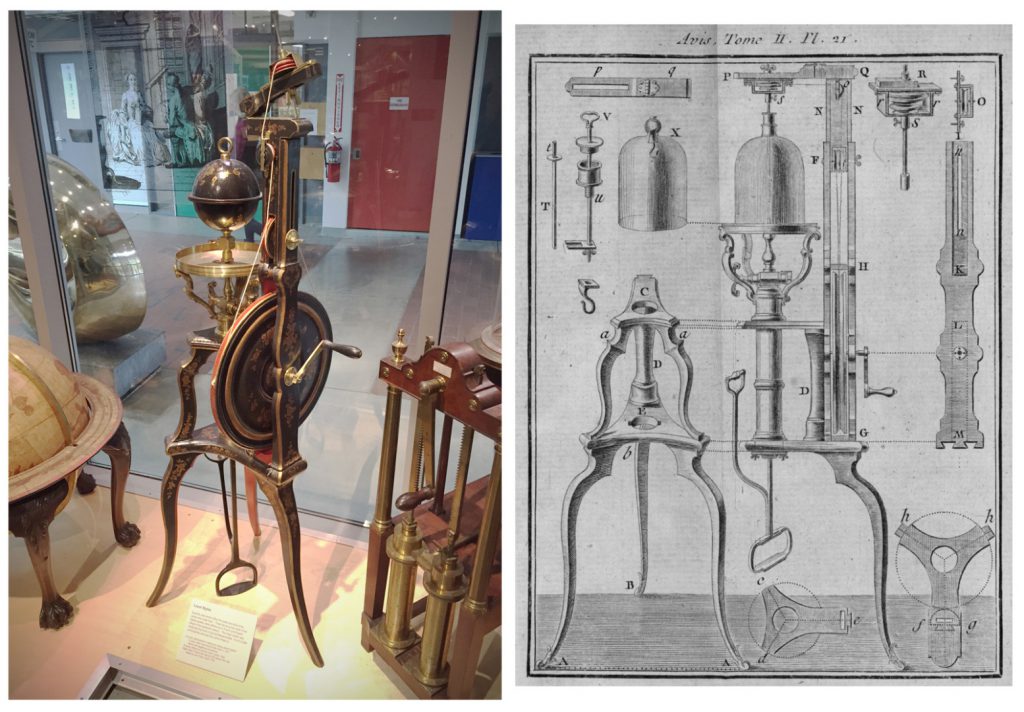
The instrumentation style, sophistication and system of production introduced by Nollet was actually an entrepreneurial business strategy developed to satisfy the taste of the coveted clientele he aspired to enlighten, i.e. the French aristocracy and bourgeoisie. He apparently did quite well for himself during a career spanning over forty years – according to financial records found in Nollet’s inventaire après décès (Turner, 2002, p 39). Though Nollet admitted in the Leçons de physique expérimentale that he would be ‘hardly flattered if people flocked to me only for visual effects’, he fully enjoyed ‘the elegance of instruments, which now adorn our schools and the cabinets of amateurs’.
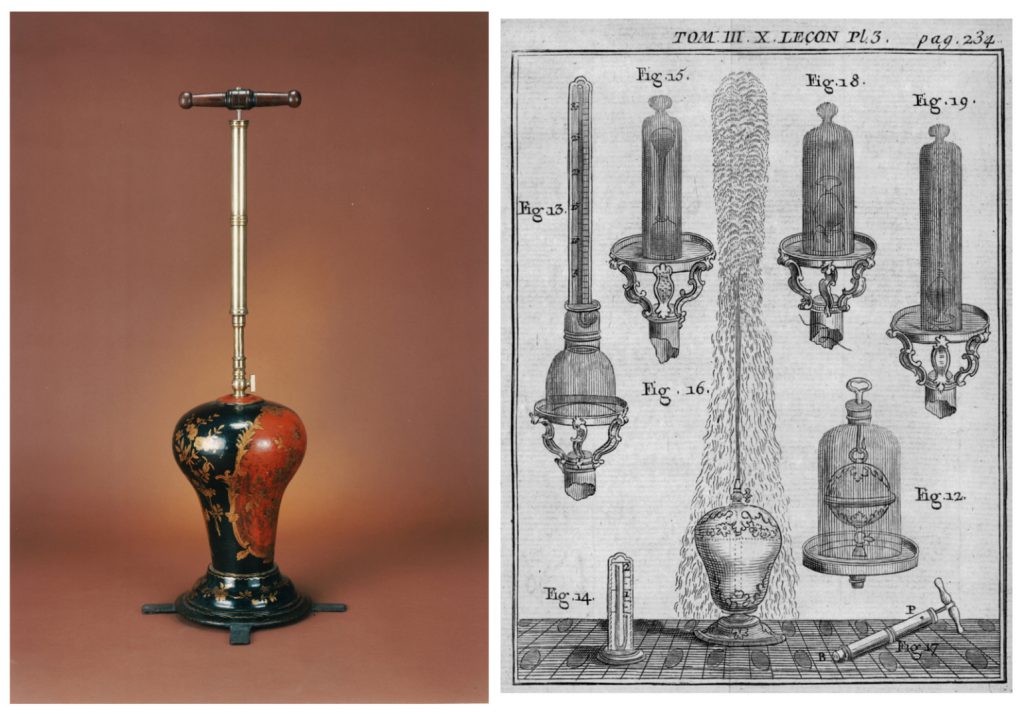
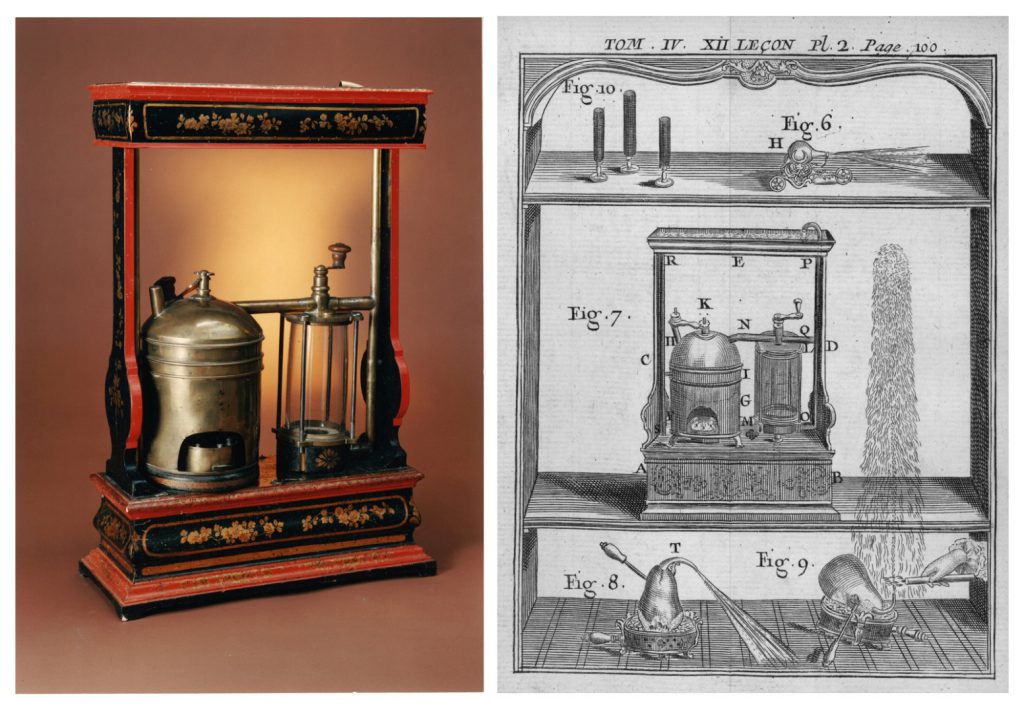
However, he continued, ‘[t]he facts discovered owe nothing in their certainty or in their utility to ornament, but when these facts are shown more gracefully it may be hoped that they will evoke greater interest’ (Nollet, 1759, pp xxix and lxxxj). Voltaire’s physics cabinet at the Château de Cirey, in large part equipped by Nollet in the late 1730s, is certainly a prime illustration of this ornamental/fact-finding instrument concord. To Voltaire, within the salon setting occupied by the Marquise du Châtelet (one of the great Enlightenment mathematicians) and various guests and philosophes de passage, the Abbé’s instruments epitomised the lavishness of a polite décor and the Newtonian experimental natural philosophy he was then busy introducing in France (Gauvin, 2006; Shank, 2008). The machines designed by Nollet and other eighteenth-century lecturer demonstrators not only highlighted the active powers found in matter – electricity being a foremost example – but also showcased, as a form of entertainment, the theological and moral implications of such controlled experiments. As (Simon Schaffer (1994, p 159)) convincingly demonstrates ‘[d]emonstration devices were designed to teach truths about nature, and the gestures which accompanied them were supposed to be invisible’. The active powers came from the machines themselves, transforming the natural philosopher into an invisible special representative of nature (Schaffer, 1983).
On a shelf in a physics cabinet Nollet’s instruments symbolised social status, new pedagogical standards and, to the connoisseur, a special type of scientific knowledge – Newtonianism. It was only through the repetitive use of the instruments, however, that one could fully embrace the mechanical, theological and moral implications of nature’s active powers. Without the former, the latter doesn’t mean much at all. Nollet’s mastery of nature depended on his mechanical skills as an artiste and the savoir-faire demonstrated during the well-choreographed lecture demonstrations. Instrument aesthetic – the fact these mechanical devices were designed to be pleasing to the eye – was an integral and essential feature of their all-encompassing functions. But certainly not the only one, as a modern visitor would mistakenly be led to believe if she saw Nollet’s instruments in a museum.
Science museums and the display of instruments
https://dx.doi.org/10.15180/160506/004In the late 1980s (Peter Galison (1988, p 211)) described what was – and perhaps still is – one of the most interesting and ambitious programmes of instrument research when he wrote:
We need a history of the material culture of science, but one that is not the dead collection of discarded instruments. In its place we need a history of the way that scientists deploy objects to meet experimental goals whether or not these were set by high theory; a history of instrument-construction linked to the history of technology; a history that encompasses the relation of instruments to forms of demonstration; a history of the laboratory that tracks the development of the organization of scientific work; and a history of the embodiment of theory in hardware.
Going over Galison’s argument the editors of a special Osiris issue on scientific instruments acknowledged a few years later ‘[t]he traditional mix of experiment and theory needs a new ingredient – instruments. It is not just a matter of getting the quantities right; we need an entirely new recipe’ (van Helden and Hankins, 1994, p 6). No institution is better equipped than a science museum to tackle the ‘dead collection of discarded instruments’.
The intellectual undertaking laid out by Galison was also identified by (Gerard L’E Turner (1987)) in his Presidential address to the British Society for the History of Science. In looking at ‘scientific toys’ over the longue durée, Turner questioned in the conclusion whether the new model of science centre and its appeal to homo ludens was entirely satisfactory. He recognised that in both the old-style science museums and the novel science centres the ‘historical element is excluded’, therefore concealing the crucial transmission of craft skills and the economic and social factors on which the making of scientific instruments depends. For (Steven Shapin (1992)) it is more than just a case of historical amnesia: it is about the processses by which science is made. Scientists need not be viewed as magicians, brandishing a magic wand called ‘the scientific method’ – which provides the solution to every scientific problem. Shapin believes that to counteract this erroneous, and potentially dangerous, image of science we need to show and explain such things as:
… the collective basis of science, which implies that no single scientist knows all of the knowledge that belongs to his or her field; the ineradicable role of trust in scientific work, and the consequent vulnerability of good science to bad practices; the contingency and revisability of scientific judgment, and thus the likelihood that what is pronounced true today may, without culpability, be judged wrong tomorrow; the interpretative flexibility of scientific evidence, and the normalcy of situations in which different good-faith and competent practitioners may come to different assessments of the same evidence.
Shapin, 1992, p 28
This is the narrative science museums – and perhaps more importantly science centres – need to produce to demystify and de-aestheticize science. In this context scientific instruments are indeed an essential ingredient to support the recent science, technology and society (STS) programme.
What seemed novel twenty-five years ago has become nowadays textbook material – in academia and, one should add, in an increasing number of science museums. Historians, philosophers and sociologists of science have recognised the key role instruments play – and have historically played – in the structure and development of a robust scientific community. According to philosopher of science (Ian Hacking (1996, pp 68–69)), for instance, instruments were often seen as better epistemic unifiers than grand unified theories during the twentieth century. One could even consider an ‘instrumentalist’ thesis, he says, that would enunciate the following: ‘…it is not high-level theory that has stopped the innumerable branches of science from flying off in all directions, but the pervasiveness of a widely shared family of experimental practices and instrumentation’. The sociologist of science (Terry Shinn (2000, pp 467–70)) also observes in the ‘universal practices’ begotten through ‘generic’ or ‘root’ instruments the formation of an intellectual and social cohesion that thwarts the effect of centrifugal forces pulling apart the various scientific disciplines. From Bruno Latour’s early concept of science in action and actor-network theory to Andrew Pickering’s dialectical mangle of practice, Otto Sibum’s performative gestural knowledge, and Peter Galison’s trading zones, contemporary scholarship in science studies by and large focuses on experimental practices, where the intricate and physical operation of instruments has become one of the chief points of analysis. Often defined as ‘tacit knowledge’, the study of laboratory performance is not an easy task to solve. (Harry Collins (2010)) spent most of his career sorting out the various accounts and interpretations of tacit knowledge in relation to not only scientific practices but to life itself.
Science museums have a fundamental role to play in presenting – and preserving – the past, present and future of scientific research. In doing so, their collections of instruments and technological devices are an asset that needs to be better exploited. How? (Simon Schaffer (2011, p 707)) observes that instruments in ‘states of disrepair’, those which show signs of heavy wear and tear, are often deemed unworthy of display. It is, he argues, a mistake and offers ‘a plea for shows of shards and fragments alongside glamorous devices’. Such an original presentation would bring to the forefront the crucial role of recycling – often referred to as cannibalising – in early modern and modern science. These material culture practices of repair, adaptation and reuse can be easily associated to contemporary work in environmental history, a research topic gaining momentum in academia over the last few years (Werrett, 2013). In the words of a former director of the Science Museum, London: ‘In a technical museum objects are shown on account of their utility, not for their beauty or their attractiveness.’[16] This statement from 1922 seems to have lost most of its weight nowadays. Displays of instruments in science museums appear closer than ever to those of decorative arts artefacts than to the presentation of real functional and practical objects. As I have explained above, ‘beauty’ is often an integral feature of an instrument’s purpose and function. Decorative art analyses also open new approaches to the contextual understanding of such objects (Dunn, 2014). In most cases, however, overly polished and shiny instruments on display simply do not convey the real biography of the instrument. As long as they remain trapped in their glass cases these instruments will never fully express their full historical narrative and practical functions. Going beyond the very superficial understanding of science requires innovative hands-on approaches to historical instruments. As Baudrillard (2015, p 92) asserts: ‘An object no longer specified by its function is defined by the subject, but in the passionate abstractness of possession all objects are equivalent.’ All objects are not equivalent. It is often their specific functions that define them. It is the role of science museums to explain and demonstrate why it is so in the case of scientific instruments and technological devices.
Tags
Footnotes
Back to text
Back to text
Back to text
Back to text
Back to text
Back to text
Back to text
Back to text
Back to text
Back to text
Back to text
Back to text
Back to text
Back to text
Back to text
Back to text




